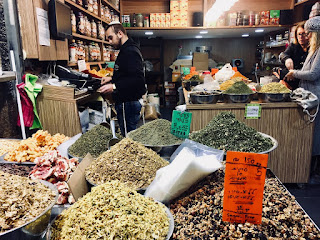Fermentation
Again, this blog is double dipping. Sorry for the lack of blogs but my computer broke and that makes it very challenging to find opportunities to post. So check out this blog here or next week at alleghenymountaininstitute.org.
I used to think fermentation meant turning something into alcohol, like wine or beer. Now, after months of cooking whole foods, learning nutrition, and our wonderful fermentation lesson, I have a whole new perspective.
I used to think fermentation meant turning something into alcohol, like wine or beer. Now, after months of cooking whole foods, learning nutrition, and our wonderful fermentation lesson, I have a whole new perspective.
Fermentation is formally defined as
the chemical breakdown of a substance by bacteria, yeasts, or other
microorganisms. And this occurs with more than just beer and wine. It occurs in
chocolate, coffee, sourdough, sprouted beans, yogurt, sauerkraut, ginger beer and
pickled fruits and vegetables. There are also some foods that I never even
heard of until AMI, like kimchi, kombucha, ginger soda, and kefir. So why do
all of my favorite foods have this in common? What is the purpose of putting
live microorganisms in our food?
 Rose (fermenter extraordinaire and
workshop instructor) and Carter (AMI’s farm manager) helped explain the five main
benefits that these microorganisms are giving us.
Rose (fermenter extraordinaire and
workshop instructor) and Carter (AMI’s farm manager) helped explain the five main
benefits that these microorganisms are giving us.
Picture 1 and 2: We are all excited to have a ginger bug
ferment to make ginger soda from. See the before and after.
1)
Health:
Fermentation can happen because bacteria eat the food it lives in and create
something new from it. For example, I have a sourdough starter made up of an
even mix of water and flour for the bacteria to eat. As they eat the mixture, I
have to keep feeding the bacteria so they can survive. This makes the smells and
texture of the dough change. By eating the mixture, the yeasts are
pre-digesting the dough for us. This makes fermented food more digestible for
humans because it has already been eaten once before we eat it- kind of like a
mother bird does for her baby! In addition to being more digestible, we get
more probiotics in our body, helping our immune system.
Picture 3: Sofia has inspired all of us to create our own
sourdough starters that we feed everyday.
2)
Safety:
Have you ever tried raw or undercooked beans? One cool fermentation process we
learned was sprouting beans. We soak them overnight, and then rinse them a
couple times a day until they form sprouts. This process renders a previously
inedible food delicious and nutritious. Other foods that are made possible to
consume by fermentation are soybeans, cocoa beans, and hops.
3)
Preservation:
As we are getting pounds and pounds of cabbage and cucumbers a week, we are in
desperate need of a way to preserve them. The lactic acid that builds from the
bacteria naturally preserves many fruits and vegetables, through a process
called lacto-fermentation. Additionally, by putting a yogurt or kefir culture
in milk you can preserve that as well.
 |
| Sophia has inspired all of us to create our own
sourdough starters we feed each day.
|
5)
5) New
flavors: The byproducts of fermentation are still a little incomprehensible
to me. How can I put a kefir starter (a culture with probiotics that has
usually been passed down multiple generations) into milk and simply by doing
this, change the taste and consistency? It is amazing to me that anyone can
create alcohol, sour flavors, vinegar, and more from basic foods like milk or
tea.
With all of our ferments, I am beginning to see a world of
life within our food. I always thought my food needed to be dead before
consuming it (though I did eat a live fish on a bet once), but now I see how
most of our food is swimming with live bacteria, waiting to aid our digestive
systems. So while fermentation often takes planning ahead and caring like you
would for any other living plant or pet, it is well worth it for me. I am
excited to make sprouted beans, sourdough, and Kombucha staples in my diet
after AMI, and hopefully, I’ll continue adding more as I keep learning and
experimenting.




Comments
Post a Comment